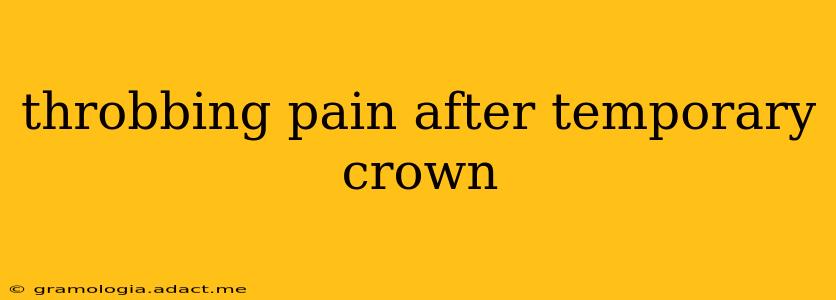Experiencing a throbbing pain after getting a temporary crown is understandably concerning. While some minor discomfort is expected, a throbbing pain warrants attention. This comprehensive guide will explore the potential causes of this pain, offer solutions for managing it, and advise you on when it's crucial to seek professional dental help.
What Causes Throbbing Pain After a Temporary Crown?
Several factors can contribute to a throbbing pain following the placement of a temporary crown. These include:
-
Irritation of the Gums: The temporary crown itself, or the cement used to secure it, might be irritating your gums, leading to inflammation and pain. This is often a mild discomfort but can become throbbing if left untreated.
-
Infection: Bacteria can enter the space between the temporary crown and the prepared tooth, causing an infection. This is a serious concern and can result in significant throbbing pain, swelling, and possibly even fever.
-
High Bite: If your bite is too high after the crown placement, it can put excessive pressure on the tooth and surrounding tissues, causing a throbbing ache. This often feels worse when biting down.
-
Tooth Sensitivity: The temporary crown might not perfectly seal the tooth, leaving it exposed to temperature changes and potentially causing sensitivity and throbbing pain.
-
Existing Underlying Issues: Pre-existing conditions like tooth decay, gum disease, or nerve damage can be exacerbated by the temporary crown, leading to increased pain.
How to Manage Throbbing Pain After a Temporary Crown?
While professional dental care is essential for resolving the underlying cause, you can take steps to manage the throbbing pain in the meantime:
-
Over-the-Counter Pain Relief: Nonsteroidal anti-inflammatory drugs (NSAIDs) like ibuprofen or naproxen can help reduce pain and inflammation. Always follow the dosage instructions on the packaging.
-
Saltwater Rinse: Gently rinsing your mouth with warm saltwater can help reduce inflammation and clean the area around the temporary crown.
-
Cold Compress: Applying a cold compress to the outside of your cheek can help numb the area and reduce swelling.
-
Soft Foods: Stick to soft foods that don't require excessive chewing to avoid putting pressure on the affected tooth.
Is Throbbing Pain After a Temporary Crown Normal?
No, throbbing pain is generally not considered normal after getting a temporary crown. While some mild sensitivity or pressure is expected, throbbing pain indicates a potential problem that needs attention.
When Should I See My Dentist About Throbbing Pain After a Temporary Crown?
You should contact your dentist immediately if you experience:
- Severe throbbing pain: Pain that is intense and doesn't respond to over-the-counter pain relief.
- Swelling: Noticeable swelling in your gums or face.
- Fever: A temperature above 100°F (37.8°C).
- Pus or drainage: Any discharge from around the temporary crown.
- Increased pain: Pain that worsens over time.
How Long Does the Pain From a Temporary Crown Last?
The duration of pain varies depending on the cause. Minor irritation might resolve within a day or two, while more significant issues could require treatment before the pain subsides. If the pain persists for more than a couple of days or worsens, consult your dentist promptly.
Can a Temporary Crown Cause a Toothache?
Yes, a poorly fitted or infected temporary crown can absolutely cause a toothache, often manifested as a throbbing pain. The temporary crown may not provide a sufficient seal against irritants or bacteria, causing inflammation and pain within the tooth.
What Happens If I Leave Throbbing Pain From a Temporary Crown Untreated?
Ignoring throbbing pain from a temporary crown can lead to more serious complications, including:
- Severe infection: The infection could spread, potentially requiring more extensive treatment.
- Loss of the tooth: In severe cases, the infection could cause irreversible damage to the tooth, resulting in its loss.
- Increased dental costs: Early intervention often leads to less costly treatments compared to waiting until the problem worsens.
Addressing the throbbing pain promptly prevents potential complications and allows your dentist to identify and correct the problem efficiently. Don't hesitate to schedule an appointment if you're experiencing any concerning symptoms. Your oral health is paramount.
